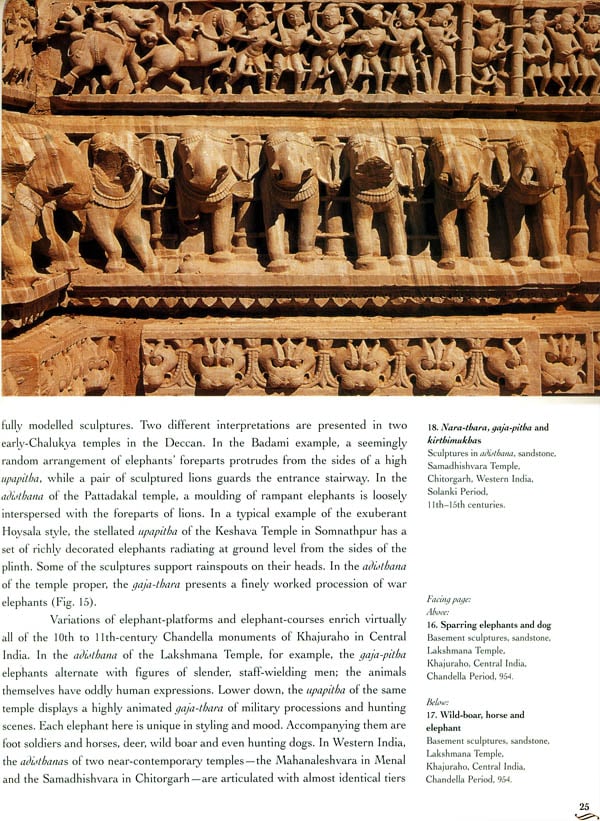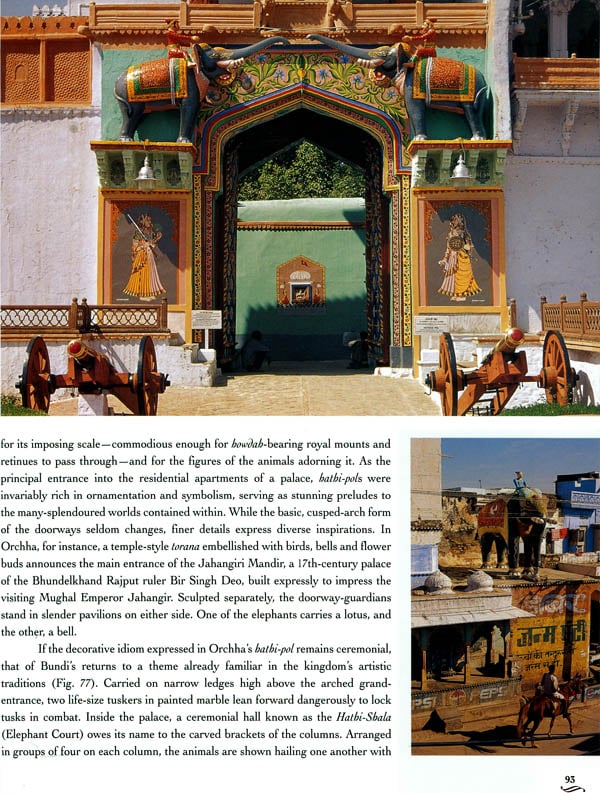
Elephant Kingdom (Sculptures from Indian Architecture)
Book Specification
| Item Code: | NAK162 |
| Author: | Vikramajit Ram |
| Publisher: | Mapin Publishing Pvt. Ltd. |
| Language: | English |
| Edition: | 2007 |
| ISBN: | 9788188204687 |
| Pages: | 104 (Throughout Color Illustrations) |
| Cover: | Paperback |
| Other Details | 11.0 inch x 9.0 inch |
| Weight | 580 gm |
Book Description
Elephants occupy a special place in the life and art of India. Since ancient times, they have been treasured and pampered as the ultimate beasts of burden, venerated as the vehicles of gods and kings and even worshipped in their own right. Their legendary attributes of strength, intelligence, nobility and longevity are eulogized in myth, epic and popular literature. In the figural and decorative arts, elephants provide an enduring fascination.
Elephant Kingdom traces the myriad stories and symbolisms behind India's much-loved animal through its depictions in architectural sculpture. At the heart of the study is a collections of photographs form a diversity of antique settings many of them in remote parts of the subcontinent. At centuries old temples, monasteries, forts an palaces, elephants flank ceremonial entrances enrich columns and capitals, form balustrades to stairways or stand as enigmatic sentinels of vast courtyards. Some are legendary characters in tales of dreams and salvation: others enact scenes from a faithfully observed natural history. Some transport kings and heroes into battle and the bunt; others are celestial messengers of rain, fertility and good fortune. From monumental freestanding sculptures to finely – worked narrative friezes, the warmth and energy of these depictions bear testimony to the achievements of countless anonymous artitsans. The result of a series of journeys to places where elephants still endure in stone, this book is not only an album of inspirations and motifs unique to India, but also a record of the special status ascribed to these majestic – and now endangered – giants of the animal world.
Vikramajit Ram Trained at the National Institute of Design and is an independent designer and writer based in Bangalore. His photographs of architecture and sculpture have illustrated various publications including the Crafts Council of India's two-volume documentation, Stone Crafts of India.
In India Stories of elephants in life and legend have captured the imagination for countless generations. The Indian word for 'elephant', in a bewildering assortment of languages and dialects, had a way of entering our childhood vocabularies, often before we had set eyes on one. Its shape was amongst the first animals we described, with a twig in the dust or a crayon on paper. Some of our best-loved toys of sun dried clay or stuffed cotton, brought those puzzling dimensions into the grasp of our hands. Elephants visited our dreams. An encounter with the real thing invariably filled us with awe, delight and wonder.
Of the multitude of creatures indigenous to the subcontinent, the elephant stands ahead of the rest for the sheer range of its associations. The ultimate beast of burden still works alongside man in cities and forests. Its stature and gait have serve its legendary role as a vehicle of the gods and of countless earthly kings. Its temperament is eulogised in myth, epic, folklore, music and popular literature. In art and ornamentation, few other animals enjoy a wider appeal.
The archetypal image of the Indian elephant festooned in finery and bearing a turbaned rider on its back – lends to the species a mystique generally denied to its African cousin. Traditional artefacts in a variety of materials – from paint and precious metals to silk, stone, wood and ironically, ivory – celebrate the processional theme in styles as diverse as their provenance. The image is also ubiquitous in Indian architectural sculpture. But here, alongside the archetype, appear scenes from other elephant realms that the scope of the artefact has rarely explored.
Figural art in sacred and royal architecture yields a wealth of information on virtually every facet of the subcontinent's manmade, imaginary, and natural worlds. Since ancient times, temples and palaces have provided hospitable settings for various art forms to flourish. Stone sculpture, in particular, was to evolve as integral component of architecture, lending itself to some of the most enduring impressions of different themes and inspirations- many of them echoed in reality at the very same settings. That sculptured stone elephants show up with unerring regularity in Buddhist, Jain and Hindu architecture is hardly surprising given that these traditions more than any other, have consistently acknowledged the animal for its mythical, ceremonial symbolic and earthly associations. It is these associations and typical settings that, in turn, inform the title of this book.
The examples of works featured in the volume span over two thousand years of architectural sculpture: the earliest, dating from the 3rd century BCE; the most recent' from the late 18th century. All were documented in their original settings - chapels and monasteries, stupas, temples, palaces and cenotaphs at sites within the boundaries of modern India. Against this broad canvas, the selection of images aims to demonstrate the many parallels and connections that exist between different interpretations. And also to highlight examples unique to a specific period or place. The images are organized around four thematic chapters that provide the historical and cultural frameworks to viewing them. The first chapter, Heaven and Magic', traces the stories and meanings behind the depiction of elephants in sacred art. The second, life and Surrender', follows the animal to its natural world and witnesses its early encounters with capture and domestication. Pomp and Circumstance' pays homage to the royal elephant and the war elephant. Finally, sentinel and Cipher' looks at symbolism in two distinct perspectives in architecture: the guardian elephant and the lion – elephant motif. Uniting them all is the power of the sculptures themselves, as their subjects loom over gateways, transport gods and heroes, or calmly traverse pleasant spheres.
Face of a deity, favourite souvenir, the Indian elephant today pays a heavy price for enchanting our lives for thousands of years. Its jungles are shrinking. A bloody and clandestine trade continues. Tired and dusty, many beg at temples or ferry tourists into forts. Tales to valour and companionship are largely forgotten. But perhaps behind their inscrutable smiles, the elephant remember.
The result of a series of journeys to places where India's elephants still survive in stone, this book is a tribute: to the anonymous artisan who rendered his subjects with warmth and affection: to those who have dedicated their lives to protecting a species; to others who still believe that elephants are magical; and to the elephants of our memories in whose footprints we have placed our own.
| Preface | 6 |
| Heaven and Magie | 8 |
| Life and Surrender | 44 |
| Pomp and Circumstance | 62 |
| Sentinel and Cipber | 82 |
| Notes | 96 |
| Glossary | 98 |
| Bibliongraphy | 101 |
| Map | 102 |
| Sites referred to in the text and photographs | 103 |
| Acknowledgement | 104 |








